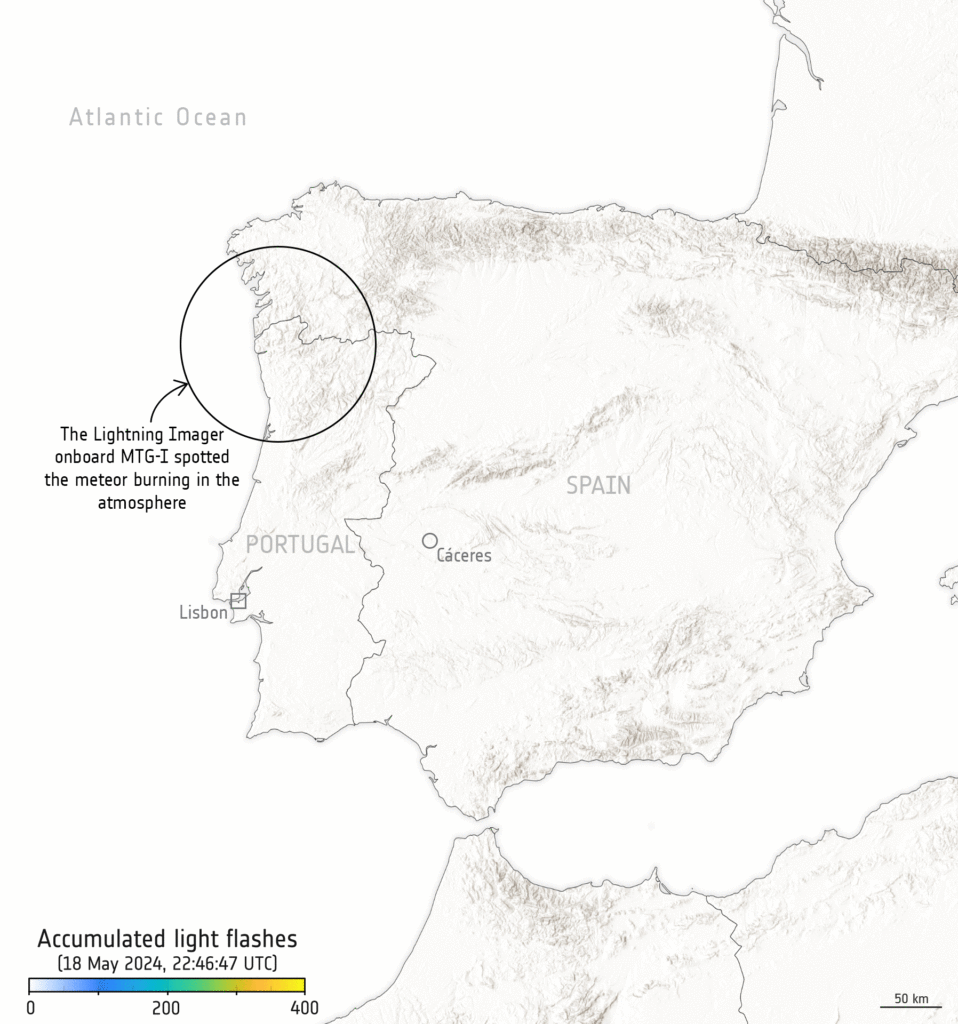The 18 May 2024 superbolide over the Iberian Peninsula: USG space sensors and ground-based independent observationsOPEN ACCESS
Eloy Peña-Asensio, Pau Grèbol-Tomàs, Josep M. Trigo-Rodríguez, Pablo Ramírez-Moreta, Rainer Kresken
Submitted to MNRAS, Preprint 27 May 2024, replaced with version 2 (preprint 28 May 2024)
“[VERSION 2, 28 May]: On 18 May 2024, a superbolide traversed the western part of the Iberian Peninsula, culminating its flight over the Atlantic Ocean and generating significant media attention. This event was caused by a weak carbonaceous meteoroid of 89.8±0.4 cm, with a density of 1660 kg m−3, entering the atmosphere at 41.6 km/s−1 with an angle of 10.9°. The luminous phase started at 138 km and ended at an altitude of 54 km. The meteoroid’s heliocentric orbit was characterized by an inclination of 15.4°, a high eccentricity of 0.965, a semi-major axis of 3 au, and a notably short perihelion distance of 0.11 au. The superbolide was recorded by multiple ground-based stations of the Spanish Meteor Network (SPMN), the European Space Agency (ESA), and the U.S. Government (USG) space sensors. Our analysis shows a relatively good agreement with the radiant and velocity data reported by the Center for Near-Earth Object Studies (CNEOS), with a deviation of 1° and 1.2 km/s−1, respectively. Due to the absence of observable deceleration, we successfully reconciled satellite radiometric data with a purely dynamic atmospheric flight model, constraining the meteoroid’s mass and coherently fitting its velocity profile. The inferred bulk density and aerodynamic strength of the meteoroid from the flight model are compatible with the properties recently measured for sample-returned materials from asteroid Bennu. The physical properties and the orbital results suggest that this meteoroid originated from a recent disruption of a comet, indicating the existence of hazardous meter-sized projectiles arriving on Earth from objects formed in the distant regions of the Solar System.”
“[VERSION 1, 27 May]:On 18 May 2024, a superbolide traversed the western part of the Iberian Peninsula, culminating its flight over the Atlantic Ocean and generating significant media attention. This event was caused by a weak carbonaceous meteoroid of 93.0±0.8 cm, with a density of 1613±12 kg m−3, entering the atmosphere at 40.1±0.4 km s−1 with an angle of 10.93±0.02◦. The luminous phase started at 137.88±0.05 km and ended at an altitude of 53.78±0.07 km. The meteoroid’s heliocentric orbit was characterized by an inclination of 14.42±0.23◦, a high eccentricity of 0.950±0.004, a semi-major axis of 2.31±0.13 au, and a notably short perihelion distance of 0.116±0.003 au. The superbolide was recorded by multiple ground-based stations of the Spanish Meteor Network (SPMN), the European Space Agency (ESA), and the U.S. Government (USG) space sensors. Our analysis shows a good agreement with the radiant and velocity data reported by the Center for Near-Earth Object Studies (CNEOS), with a deviation of 1.6◦ and -0.4 km s−1, respectively. Due to the absence of observable deceleration, we successfully reconciled satellite radiometric data with a purely dynamic atmospheric flight model, constraining the meteoroid’s mass and coherently fitting its velocity profile.”
CLICK IMAGE FOR ANIMATION OF RECORDED LIGHT FLASHES

Bolide’s luminous trail recorded by the Lightning Imager on ESA’s Meteosat Third Generation Imager (MTG1). Animation: ESA
SOCIAL MEDIA
The bolide recorded by Milena Refacho. Video: Milena Refacho
Dashcam video showing almost the whole 554-kilometre long luminous trail, recorded while driving north on the Autostrada do Norte (A1) around location 39°08’13.3″N, 8°53’33.4″W, which is 201 km on the ground from the bolide’s energy peak at 77.91±0.04 km above location ~40.8851 N, 8.2932 W, and 298.6 km (on the ground) from the beginning of bolide’s luminous trail at a height of 137.88±0.05 km above location 38.5777 N, 5.5197 W and 341.2 km on the ground from the end of the luminous trail 53.78±0.07 km above location 42.112 N, 9.885 W. The woman seems to ask in Russian “Что это?” (What’s this?) Video: 2urbangirls
The bolide recorded by ESA’s Planetary Defence Office’s AllSky7 camera (AMS82) in Casas de Millán, Cáceres, Spain at ~39°49’00.3″N, 6°19’49.9″W, which is 204.4 km on the ground from the bolide’s energy peak at 77.91±0.04 km above location ~40.8851 N, 8.2932 W. SOURCE VIDEO (MP4) Video: ESA/PDO/AMS82 AllSky7
Bolide recorded by Miguel A. Furones’s southern and western SPMN cameras in Navianos de Valverde-Zamora at 41°57’11.6″N, 5°48’48.4″W, which is 238.4 km on the ground from the energy peak at 77.91±0.04 km above location ~40.8851 N, 8.2932 W. Animation: Miguel A. Furones/SPMN
Video showing the fragmentation at the end of the luminous trail. Video: unknown
Video: Domenico (@AvatarDomy)
































